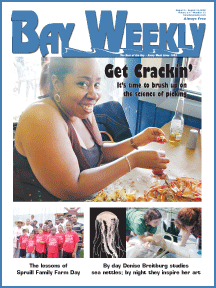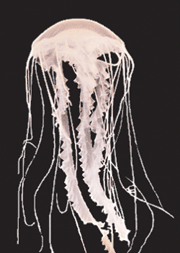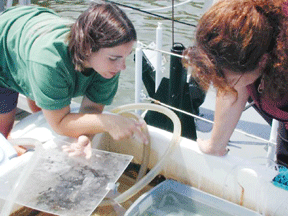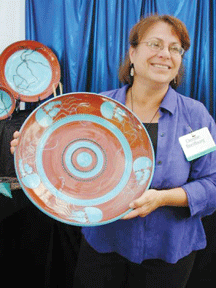
Volume XVII, Issue 32 # August 6 - August 12, 2009 |
 |
Working Overtime
By day marine biologist Denise Breitburg studies sea nettles; by night they inspire her art
by Margaret Tearman
Silent. Ethereal. Menacing.
Jellyfish.
The diaphanous creatures appear every summer, seemingly from out of nowhere. In just days, they change summer’s siren song from Whoopee! Everybody in the water to Yikes! Enter at your own risk.
Who could love such a creature?
Smithsonian Environmental Research Center scientist Denise Breitburg, for whom they’re both work and play.
Jellyfish Facts |
|
|
 Shaping the Potter
Shaping the Potter
Denise Breitburg sees jellyfish as beautiful creatures with a job to do in the Chesapeake Bay’s ecosystem.
The senior scientist studying the gelatinous species — known as ctenophore — is also an accomplished potter. Combining her two passions — jellyfish and clay — has given her a unique niche in the classification of species.
This marriage of art and science consummates a lifelong dream.
“I dreamed that I would teach biology at the junior college level part-time,” Breitburg tells Bay Weekly, “and be a potter part-time.”
Breitburg began working with clay while an undergraduate student in Albany and Arizona. She was smitten with the process.
“Everything about pottery is magical,” she says, “from the hypnotic spin of the potter’s wheel, to the transformation of a shapeless lump to a graceful shape, to the mystery of colors appearing in the heat of the kiln.”
In graduate school at the University of California Santa Barbara, she and her husband Mark Smith, also a potter, found a vibrant potting community where she honed her craft.
“In seven years in Santa Barbara, I spent more time at the pottery studio than in the biology lab,” the scientist recalls.
In 1984, the family moved to Calvert County, and Breitburg went to work in Benedict, at the lab that’s since become Morgan State University’s Estuarine Research Center at Jefferson Patterson Park.
“At the time there was no place in Calvert to do pottery,” Breitburg says.
Art took a back seat to jobs and family, as she and Mark raised their two children, son Eli and daughter Maya. Eli is producing a rock opera in Baltimore and Maya is in Fiji, serving with the Peace Corps.
Sympathy for Sea Nettles
Jellyfish came later in Breitburg’s career. Her compelling interest as a marine biologist was how species interact and use habitat.
|
|
![]() “I was doing research on low-oxygen dead zones in the Chesapeake Bay,” says Breitburg. “We were studying fish populations, and we started wondering how low oxygen affects interaction among species.”
“I was doing research on low-oxygen dead zones in the Chesapeake Bay,” says Breitburg. “We were studying fish populations, and we started wondering how low oxygen affects interaction among species.”
The unloved sea nettle intrigued her.
“They are so beautiful,” she says, “so simple compared to fin fish, yet they can dominate an ecosystem.”
Their abundance began to tell her about the health of the ecosystem.
Believe it or not, nettles peaked in the 1960s and ’70s.
“Studies showed the decline in sea nettles were concurrent to the decline in oysters,” explains Breitburg. “The nettles have an over-winter stage during which they live attached to oyster shells. When oyster beds collapsed, nettles lost their winter bedding, and their numbers declined, too.”
Blessing or curse, they’re now rebounding.
“Sea nettles seem to be increasing,” Breitburg says.
There may be no good omen there because, Breitburg explains, jellyfish don’t mind conditions that starve other creatures.
“Dumping too many nutrients into the water causes too much algae,” she says. “When the algae decomposes, it uses up oxygen. Sea nettles are able to survive in low-oxygen levels. So we’re creating great habitat.”
Then again, the news may be good. Rejuvenation of oysters is also increasing sea nettle numbers. More oysters also mean more jellyfish.
Which gives Breitburg more to work with.
Convergence
In more ways than one.
“Seven years ago my husband and I both turned 50,” Breitburg relates. “He’s a potter, too, and our birthday present to each other was turning our basement into a pottery studio.”
About three years ago, jellyfish invaded her studio.
Visiting Australia, Breitburg was inspired by aboriginal art.
“I love aboriginal dot paintings and their recognizable yet abstract paintings of animals,” she says. “So I started including jellyfish in my work, painting them on my platters.”
Concentric circles of dots also decorate many of her circular platters. Other sea creatures — manta rays and sea stars — also lent their forms. She favors the natural red color of terra cotta, plus colors of water in light: turquoise and pink, with black delineations.
Breitburg’s just won a spot in her first major show, with two pieces at Proximity, which continues through October 4 at Annmarie Garden.
Breitburg is also a contributing artist at CalvART Gallery in Prince Frederick and a regular at Annmarie Garden’s Artfest, where she shares a booth with her husband Mark and his clay sharks’ teeth.
“The first year we were at Artfest it was like dressing up for Halloween,” Breitburg recalls. “People we know only from our jobs saw us there and did a double take. They don’t know us as artists.”
Now they do.


